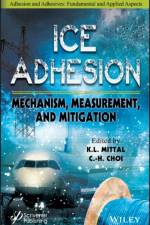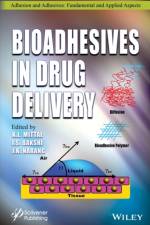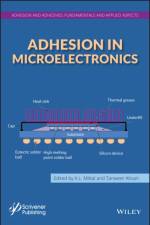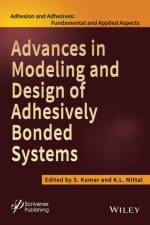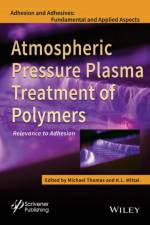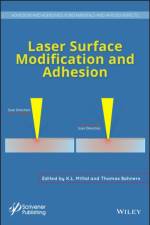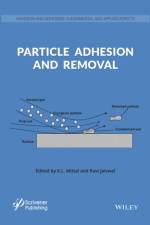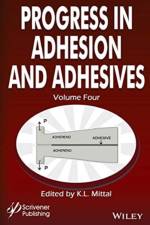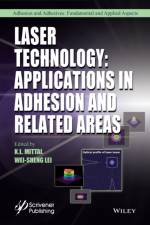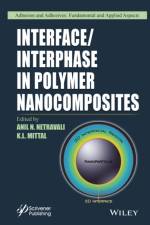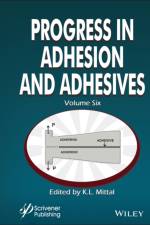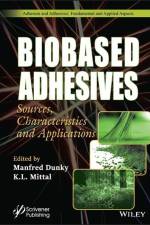Bøger i Adhesion and Adhesives: Fundamental and Applied Aspects serien
-
- Mechanism, Measurement, and Mitigation
1.893,95 kr. Das Fachbuch umfasst 18 Kapitel, die in drei Abschnitte unterteilt sind: Grundlage der Eisbildung und Eigenschaften von Eis, Eishaftung und deren Messung, Methoden zur Abschwächung von Eishaftung. Die behandelten Themen: Faktoren, die die Bildung, Haftung und Reibung von Eis beeinflussen, Eisnukleation auf festen Oberflächen, Physik der Eisnukleation und Wachstum auf Oberflächen, Kondensation und Gefrieren, Abtaueigenschaften von strukturierten Oberflächen, Zusammenhang zwischen oberflächenfreier Energie und Eishaftung auf Oberflächen, Meteorologie der Eishaftung, Testverfahren zur Quantifizierung der Stärke von Eishaftung auf Oberflächen, Ringstudien zur Stärke von Eishaftung, Mechanismen der Technologien der Oberflächenvereisung und -enteisung, Vereisungsschutz mittels mikrostrukturierter Oberflächen, Festigkeitsprüfung von eisphoben Beschichtungen, bioinspirierte eis-phobe Beschichtungen, Herausforderungen bei der rationellen Fertigung eis-phober Oberflächen, Schutz vor Eisansatz bei Flugzeugen, numerische Modellierung und deren Anwendung bei Vereisung während eines Fluges.
- Bog
- 1.893,95 kr.
-
2.211,95 kr. This important and unique book comprises 12 chapters divided into three parts examining the fundamental aspects, bioadhesive formulations, and drug delivery applications.Understanding the phenomenon of bioadhesion i.e. its theories or mechanism(s) are of critical importance in developing optimum bioadhesive polymers (used in bioadhesives). Such bioadhesive polymers are the key for exhibiting the process of bioadhesion, controlled/sustained release of drugs, and drug targeting. The use of bioadhesives restricts the delivery system to the site of interest and thus offers a useful and efficient technique for targeting a drug to the desired location for a prolonged duration. This book addresses the various relevant aspects of bioadhesives in drug delivery in an easily accessible and unified manner.The book containing 12 chapters written by eminent researchers from many parts of the globe is divided into three parts: Part 1: Fundamental Aspects; Part 2: Bioadhesive Formulations; Part 3: Drug Delivery Applications.The topics covered include: Theories and mechanisms of bioadhesion; bioadhesive polymers for drug delivery applications; methods for characterization of bioadhesiveness of drug delivery systems; bioadhesive films and drug delivery applications; bioadhesive nanoparticles; bioadhesive hydrogels and applications; ocular biodhesive drug delivery systems; buccal bioadhesive drug delivery systems; gastrointestinal bioadhesive drug delivery systems; nasal bioadhesive drug delivery systems; vaginal drug delivery systems; pulmonary bioadhesive drug delivery systems.
- Bog
- 2.211,95 kr.
-
2.058,95 kr. This comprehensive book will provide both fundamental and applied aspects of adhesion pertaining to microelectronics in a single and easily accessible source.
- Bog
- 2.058,95 kr.
-
1.931,95 kr. The book comprehensively charts a way for industry to employ adhesively bonded joints to make systems more efficient and cost-effective Adhesively bonded systems have found applications in a wide spectrum of industries (e.g. , aerospace, electronics, construction, ship building, biomedical, etc. ) for a variety of purposes.
- Bog
- 1.931,95 kr.
-
1.931,95 kr. The topic of wettabilty is extremely important from both fundamental and applied aspects. The applications of wettability range from self-cleaning windows to micro- and nanofluidics. This book represents the cumulative wisdom of a contingent of world-class (researchers engaged in the domain of wettability.
- Bog
- 1.931,95 kr.
-
- Relevance to Adhesion
2.116,95 kr. The Atmospheric Pressure Plasma (APP) treatment for polymer surface modification has attracted much attention recently, owing to its advantages over other techniques and its ability to improve adhesion without tampering with polymer's bulk properties.
- Bog
- 2.116,95 kr.
-
2.058,95 kr. The book provides a unique overview on laser techniques and applications for the purpose of improving adhesion by altering surface chemistry and topography/morphology of the substrate.
- Bog
- 2.058,95 kr.
-
2.058,95 kr. The book provides a comprehensive and easily accessible reference source covering all important aspects of particle adhesion and removal. The core objective is to cover both fundamental and applied aspects of particle adhesion and removal with emphasis on recent developments.
- Bog
- 2.058,95 kr.
-
2.211,95 - 2.305,95 kr. - Bog
- 2.211,95 kr.
-
- Recent Developments and Future Trends
2.168,95 kr. The book details the recent and exciting developments on various fronts in the textile field with regard to novel and innovative functionalities, as well as their applications in various industries. Technical textiles are used in various industries for a host of purposes and applications. Recent developments in novel and innovative functionalities to textiles include easy-to-clean or dirt-repellent, flame retardancy, anti-bacterial, and fog-harvesting properties. Textiles for electronics based on graphene, CNTs and other nanomaterials, conductive textiles, textiles for sensor function, textile-fixed catalysts, textiles for batteries and energy storage, textiles as substrates for tissue engineering, and textiles for O/W separation are prevalent as well. All this development has been made possible through adopting novel ways for finishing textiles, e.g., by appropriate surface modification techniques, and utilizing biomimetic concepts borrowed from nature. This unique book is divided into four parts: Part 1: Recent Developments/Current Challenges in Textile Finishing; Part 2: Surface Modification Techniques for Textiles; Part 3: Innovative Functionalities of Textiles; Part 4: Fiber-Reinforced Composites. The topics covered include: Antimicrobial textile finishes; flame retardant textile finishing; "self-cleaning" or easy-to-clean textiles; metallization of textiles; atmospheric pressure plasma, and UV-based photochemical surface modification of textiles; tunable wettability of textiles; 3D textile structures for fog harvesting; textile-fixed catalysts; medical textiles as substrates for tissue engineering; and fiber-reinforced "green" or "greener" biocomposites and the relevance of fiber/matrix adhesion. AudienceThe book will be of particular interest to academic and industry engineers working in polymers, materials science, textile and technology and the biomedical arena. Researchers in governmental and other research laboratories and R&D personnel in textile-related industries will find this book of great interest, value and usefulness.
- Bog
- 2.168,95 kr.
-
- Applications in Adhesion and Related Areas
2.199,95 kr. The acronym Laser is derived from Light Amplification by Stimulated Emission of Radiation. With the advent of the ruby laser in 1960, there has been tremendous research activity in developing novel, more versatile and more efficient laser sources or devices, as lasers applications are ubiquitous. Today, lasers are used in many areas of human endeavor and are routinely employed in a host of diverse fields: various branches of engineering, microelectronics, biomedical, medicine, dentistry, surgery, surface modification, to name just a few. In this book (containing 10 chapters) we have focused on application of lasers in adhesion and related areas. The topics covered include: Topographical modification of polymers and metals by laser ablation to create superhydrophobic surfaces. Non-ablative laser surface modification. Laser surface modification to enhance adhesion. Laser surface engineering of materials to modulate their wetting behavior. Laser surface modification in dentistry. Laser polymer welding. Laser based adhesion testing technique to measure thin film-substrate interface toughness. Laser surface removal of hard thin ceramic coatings. Laser removal of particles from surfaces. Laser induced thin film debonding for micro-device fabrication applications.
- Bog
- 2.199,95 kr.
-
1.813,95 kr. Significant research has been done in polymeric nanocomposites and progress has been made in understanding nanofiller-polymer interface and interphase and their relation to nanocomposite properties. However, the information is scattered in many different publication media. This is the first book that consolidates the current knowledge on understanding, characterization and tailoring interfacial interactions between nanofillers and polymers by bringing together leading researchers and experts in this field to present their cutting edge research. Eleven chapters authored by senior subject specialists cover topics including: Thermodynamic mechanisms governing nanofiller dispersion, engineering of interphase with nanofillers Role of interphase in governing the mechanical, electrical, thermal and other functional properties of nanocomposites, characterization and modelling of the interphase Effects of crystallization on the interface, chemical and physical techniques for surface modification of nanocellulose reinforcements Electro-micromechanical and nanoindentation techniques for interface evaluation, molecular dynamics (MD) simulations to quantify filler-matrix adhesion and nanocomposite mechanical properties.
- Bog
- 1.813,95 kr.
-
2.095,95 kr. The phenomenon of adhesion is of cardinal importance in the pharmaceutical, biomedical and dental fields. A few eclectic examples will suffice to underscore the importance/relevance of adhesion in these three areas. For example, the adhesion between powdered solids is of crucial importance in tablet manufacture. The interaction between biodevices (e.g., stents, bio-implants) and body environment dictates the performance of such devices, and there is burgeoning research activity in modifying the surfaces of such implements to render them compatible with bodily components. In the field of dentistry, the modern trend is to shift from retaining of restorative materials by mechanical interlocking to adhesive bonding.This unique book addresses all these three areas in an easily accessible single source. The book contains 15 chapters written by leading experts and is divided into four parts: General Topics; Adhesion in Pharmaceutical Field; Adhesion in Biomedical Field; and Adhesion in Dental Field. The topics covered include:- Theories or mechanisms of adhesion.- Wettability of powders.- Role of surface free energy in tablet strength and powder flow behavior.- Mucoadhesive polymers for drug delivery systems.- Transdermal patches.- Skin adhesion in long-wear cosmetics.- Factors affecting microbial adhesion.- Biofouling and ways to mitigate it.- Adhesion of coatings on surgical tools and bio-implants.- Adhesion in fabrication of microarrays in clinical diagnostics.- Antibacterial polymers for dental adhesives and composites.- Evolution of dental adhesives.- Testing of dental adhesives joints.
- Bog
- 2.095,95 kr.
-
1.948,95 kr. With the voluminous research being published, it is difficult, if not impossible, to stay abreast of current developments in a given area. The review articles in this book consolidate information to provide an alternative way to follow the latest research activity and developments in adhesion science and adhesives.With the ever-increasing amount of research being published, it is a Herculean task to be fully conversant with the latest research developments in any field, and the arena of adhesion and adhesives is no exception. Thus, topical review articles provide an alternate and very efficient way to stay abreast of the state-of-the-art in many subjects representing the field of adhesion science and adhesives.The 19 chapters in this Volume 6 follow the same order as the review articles originally published in RAA in the year 2020 and up to June 2021. The subjects of these 19 chapters fall in the following areas:* Adhesives and adhesive joints* Contact angle* Reinforced polymer composites* Bioadhesives* Icephobic coatings* Adhesives based on natural resources* Polymer surface modification* Superhydrophobic surfacesThe topics covered include: hot-melt adhesives; adhesively-bonded spar-wingskin joints; contact angle hysteresis; fiber/matrix adhesion in reinforced thermoplastic composites; bioadhesives in biomedical applications; mucoadhesive pellets for drug delivery applications; bio-inspired icephobic coatings; wood adhesives based on natural resources; adhesion in biocomposites; vacuum UV surface photo-oxidation of polymers and other materials; vitrimers and their relevance to adhesives; superhydrophobic surfaces by microtexturing; structural acrylic adhesives; mechanically durable water-repellent surfaces; mussel-inspired underwater adhesives; and cold atmospheric pressure plasma technology for modifying polymers.AudienceThis book will be valuable and useful to researchers and technologists in materials science, nanotechnology, physics, surface and colloid chemistry in multiple disciplines in academia, industry, various research institutes and other organizations.
- Bog
- 1.948,95 kr.
-
2.223,95 kr. Biobased AdhesivesUnique and comprehensive book edited by acknowledged leaders on biobased adhesives that will replace petroleum-based adhesives.This book contains 23 chapters covering the various ramifications of biobased adhesives. The chapters are written by world-class scientists and technologists actively involved in the arena of biobased adhesives. The book is divided into three parts: Part 1: Fundamental Aspects; Part 2: Classes of Biobased Adhesives; and Part 3: Applications of Biobased Adhesives. Topics covered include: an introduction to biobased adhesives; adhesion theories and adhesion and surface issues with biobased adhesives; chemistry of adhesives; biorefinery products as biobased raw materials for adhesives; naturally aldehyde-based thermosetting resins; natural crosslinkers; curing and adhesive bond strength development in biobased adhesives; mimicking nature; bio-inspired adhesives; protein adhesives; carbohydrates as adhesives; natural polymer-based adhesives; epoxy adhesives from natural materials; biobased polyurethane adhesives; nanocellulose-modified adhesives; debondable, recyclable, and biodegradable biobased adhesives; 5-Hydroxymethylfurfural-based adhesives; adhesive precursors from tree-derived naval stores; and applications in various diverse arenas such as wood bonding, controlled drug delivery, and wearable bioelectronics.AudienceThis book will interest materials scientists, adhesionists, polymer chemists, marine biologists, food and agriculture scientists, and environmentalists. R&D personnel in a slew of wide-ranging industries such as aviation, shipbuilding, railway, automotive, packaging, construction, wood bonding, and composites should find this book a repository of current and much-needed information.
- Bog
- 2.223,95 kr.

